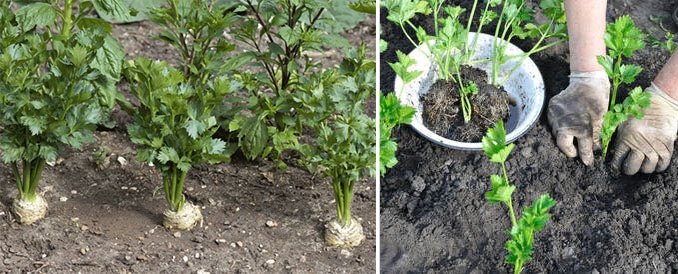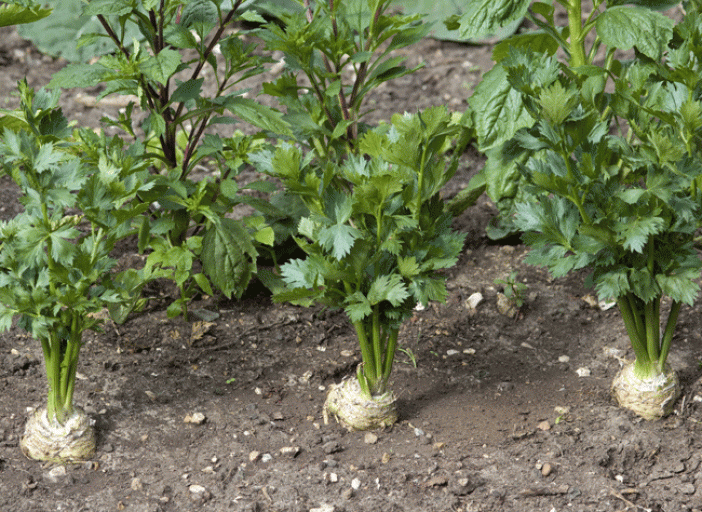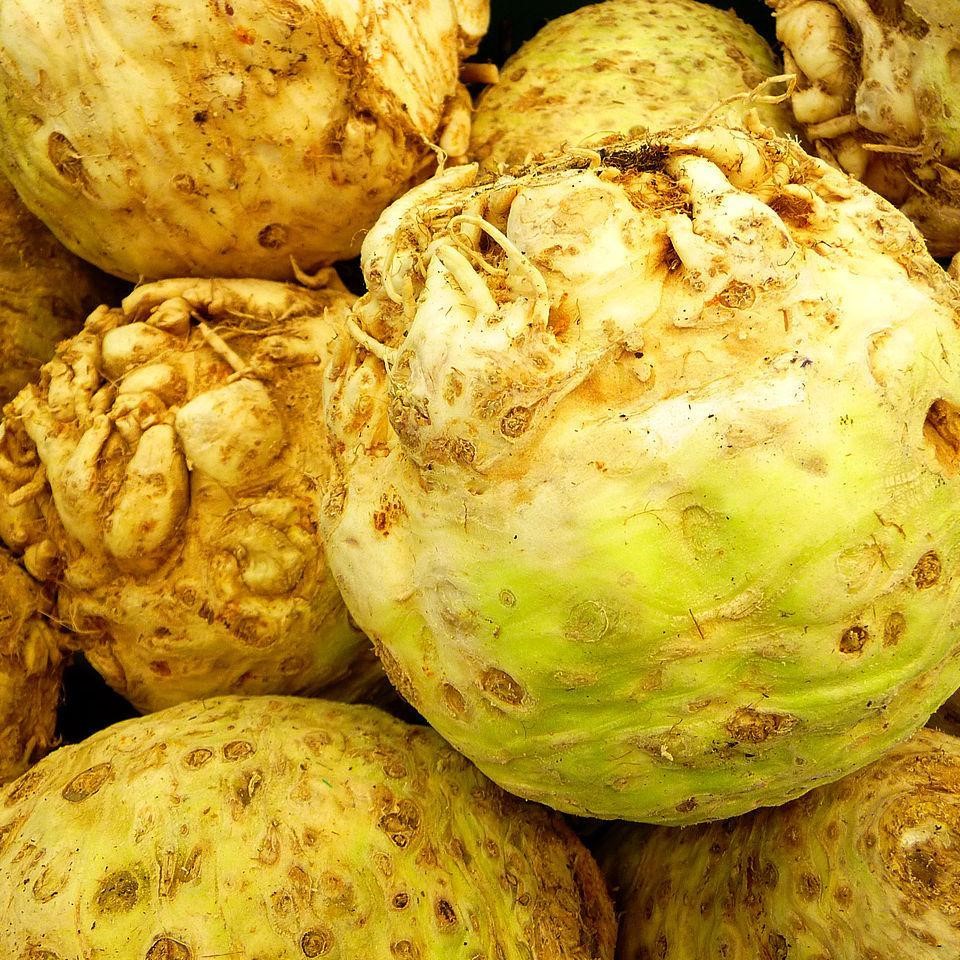When to sow celery root?
You can sow celeriac at different times of the year depending on which method you choose:
- Between February and April: this concerns sowing on a warm layer, in a greenhouse, in a box or in a heated place, because the temperature must be higher than 15 ° C.
- In mid-April: this is the ideal time for planting in the nursery provided it is well exposed.
Which varieties to choose?
There are different varieties of celeriac here are some examples:
Marble ball it is a variety with a very fine flavor and tender flesh. Its root is voluminous and it is a very productive and early variety.
The Niva : This variety of celery root offers an extremely tasty meat. The round root is important, and it supports perfectly the winter temperatures since it is one of the most rustic.
The Monarch he has firm flesh and true taste qualities. It is in the form of a round, round, ball-shaped root. It is a late variety and has the distinction of being resistant to septoria. It supports perfectly the cold, because it is very rustic. It can stay in the ground until the first frosts without problems.
Giant celery root from Prague it is in the form of a voluminous and round root. Its flesh is tender and has a fine flavor. It is an early variety.
The Shepherd Weisse Kugel : its root is round and heavy, it has a pleasant taste in the mouth. It is quite resistant to diseases and is easy to keep.
What to do before sowing celeriac?
Before sowing, it is necessary to prepare your soil: you hoe it and remove the roots, weeds, pebbles and other debris.
Then, as celery likes organic matter and needs it to grow, you bring a lot of ripe compost. You can also use a vegetable fertilizer. During the cultivation, you will put several times phosphate-rich fertilizer in sufficient quantity.
How to sow it?

It is sometimes difficult to successfully plant celeriac: its growth starts slowly and its germination is delicate. For a good result, here are the ideal conditions:
- The mini electric greenhouse is the safest way to sow hot and ensure good germination. Just make sure it has a thermostat so you can adjust the temperature.
- Place it in a place bathed in light as a frame, a veranda or a cold greenhouse. It should not be placed inside even on the window sill, it could run out of light.
- Put your seeds in a terrine or buckets filled with special seedling seedlings.
- Draw straight rows in terrine with a pencil.
- Place your seeds there, cover with potting soil and tamp a little the earth, then water in rain.
- To maintain and water it, a small watering can, a sprayer and a thermometer should suffice.
- When you transplant them, take a fork.
After sowing in a terrine or bucket, keep a wet soil by basting in a fine rain, you can cover them with newspaper to maintain a certain humidity.
The temperature of the shelter should be more than 10 ° C, this ensures a correct development to the young plants, it can be between 18 and 20 ° C. It should not be too hot, because in this situation, the plants would stop their growth.
Our advice : in a terrine and nursery, sow clear and in line, leaving a few centimeters between each line in terrine and 10 cm in nursery. In a scoop, place two or three seeds.
To transplant young plants :
- Wait until the plants have 3 or 4 leaves before transplanting.
- Make holes 10 cm apart in the fine and aerated earth.
- Place a plant in each hole, take care to remove the tip of the main root and rootlets. In this way you ensure your celeriac a good development.
- Install them in the ground from May or June when they have about 6 to 8 leaves, selecting the most beautiful subjects. Space them by 40 cm, the collar will be flush with the ground.
- Praline root: this promotes a good recovery.
To know : practicing two subcultures helps fortify the root and get big, firm balls.
The multiplication :
This is practiced only by sowing.
Where to plant celery root?

Celeriac likes sunny places, as well as temperate and humid climates. The soil should be fresh, humorous and loose. It will fertilize your soil, even if it is already rich.
You will rotate crops over four years if possible because celery quickly depletes the soil.
In the garden, you can plant cucumbers, cabbage, leeks, peas, tomatoes, baby beans, radishes or lettuce nearby. He associates himself very well with these cultures.
How to maintain it?
It is quite simple to maintain celeriac which is not particularly demanding.
- It is necessary to add vegetable fertilizer and well decomposed compost during the cultivation several times.
- Weeding and boring are essential and must be done regularly.
- To promote root growth, you can remove the outer leaves as you go.
- When its ball is well developed, you remove rootlets and outer leaves which will help promote growth.
- Straw the foot to keep the floor fresh and fresh.
Celery does not require too much maintenance:
How to water celery root?
You will sprinkle the celeriac generously especially during periods of high temperatures, you can out of these moments, water it frequently and copiously.
Harvesting celeriac: when and how?

You harvest your celeriac about 7 months after sowing.
It is then necessary to pull the roots before the appearance of first frost. You will leave them on the ground for a day and then cut the rootlets and leaves.
You will keep it in the sand and in a humid and cool place like the cellar.
Celeriac diseases and what to do?
Celeriac may be particularly susceptible to certain diseases and more specifically to celery maggot and septoria.
The celery fly it can sometimes do big damage in your crops. She lays her eggs on the leaves. Once the larvae hatch, they dig galleries, the leaves turn yellow, they curl, dry out. They end up dying and when celery is deprived of its foliage, it gives only a bulb or stunted petioles. The affected leaves should be removed and burned and the remaining plants sprayed with a biological insecticide.
Septoria : is a disease that affects the foliage and is characterized by spots of light brown color, and is dotted with black dot. This disease occurs especially when the atmosphere is too hot and humid. It is then necessary to stop watering at the end of the day, because this type of watering causes a stagnation of water on the leaves which then promotes the spread of the disease. Rain and stormy weather are bad for this disease they favor. After the rain, treat the soil with a horsetail decoction or a dandelion infusion. Renew this operation for a few days and remove the plants that are affected.
Celery rust : when the weather is wet or when temperatures drop significantly, leaves and stems of celery are covered with brown spots that are due to the rust of celery. This stops the growth of this vegetable. From the first signs of this attack, sprays of Bordeaux mixture can stop this phenomenon. If you want to prevent, use horsetail tea.
In rainy weather and at night, the main attackers of celery root are the slugs and snails. They appreciate the stems and the hearts of the plants. To avoid their attacks, put slug traps and pick up those that remain.
Our advice Do not hesitate to practice crop rotation, this often avoids pests and diseases and allows the soil not to run out. For celeriac and celery, it is done over 3 or 4 years.
Even more plantations:








